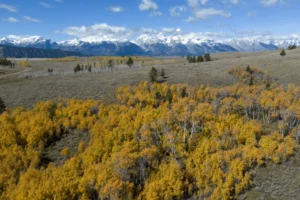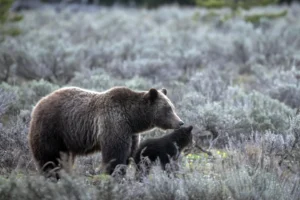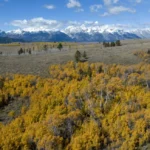Animal Groups are Urging Tourists Not to Visit Wyoming After a Man Hit a Wolf Then Took It to a Bar
- Published In: Other News & Features
- Last Updated: Apr 27, 2024

A track from a wolf is seen in the mud near the Slough Creek area of Yellowstone National Park, Wyo., Wednesday, Oct. 21, 2020. As Yellowstone National Park in Wyoming opens for the busy summer season, wildlife advocates are leading a call for a boycott of the conservative ranching state over laws that give people wide leeway to kill gray wolves with little oversight. (AP Photo/Matthew Brown, File)
BY MEAD GRUVER
CHEYENNE, Wyo. (AP) — As Yellowstone National Park in Wyoming opens for the busy summer season, wildlife advocates are leading a call for a boycott of the conservative ranching state over laws that give people wide leeway to kill gray wolves with little oversight.
The social media accounts of Wyoming’s tourism agency are being flooded with comments urging people to steer clear of the Cowboy State amid accusations that a man struck a wolf with a snowmobile, taped its mouth shut and showed off the injured animal at a Sublette County bar before killing it.
While critics contend that Wyoming has enabled such animal cruelty, a leader of the state’s stock growers association said it’s an isolated incident and unrelated to the state’s wolf management laws. The laws that have been in place for more than a decade are designed to prevent the predators from proliferating out of the mountainous Yellowstone region and into other areas where ranchers run cattle and sheep.
“This was an abusive action. None of us condone it. It never should never have been done,” said Jim Magagna, executive vice president of the Wyoming Stock Growers Association and a Sublette County rancher who has lost sheep to wolves. “It’s gotten a lot of media attention but it’s not exemplary of how we manage wolves to deal with livestock issues or anything.”
Wolves are federally protected as an endangered or threatened species in most of the U.S. but not the Northern Rockies. Wyoming, Idaho and Montana allow wolves to be hunted and trapped, after their numbers rebounded following their reintroduction to Yellowstone and central Idaho almost 30 years ago. Before their reintroduction, wolves had been annihilated in the lower 48 states through government-sponsored poisoning, trapping and bounty hunting into the mid-1900s.
Today, Wyoming has the least restrictive policies for killing wolves. There are limits on hunting and trapping in the northwestern corner of the state and killing them is prohibited in Yellowstone and neighboring Grand Teton National Park, where they are a major attraction for millions of tourists. But outside the Yellowstone region, in the 85% of the state known as the “predator zone,” they can be freely killed.
The wolf allegedly was run down, shown off and killed within the predator zone.
Wolves roam hundreds of miles and often kill cattle and sheep. Gray wolves attacked livestock hundreds of times in 2022 across 10 states including Wyoming, according to an Associated Press review of depredation data from state and federal agencies, the most recent data available. Other times livestock succumb to other predators, disease or exposure or simply go missing.
Losses to wolves can be devastating to individual ranchers, yet wolves’ industry-wide impact is negligible: The number of cattle killed or injured in documented cases equals 0.002% of herds in the affected states, according to a comparison of depredation data with state livestock inventories.
The predator zone resulted from negotiations between U.S. and Wyoming officials who traded away federal compensation for livestock killed by wolves in exchange for allowing free killing of wolves in that area.
Saharai Salazar is among out-of-staters changing their travel plans based on what allegedly happened Feb. 29 near Daniel, a western Wyoming town of about 150 people.
The Santa Rosa, California, dog trainer posted on the state’s tourism Instagram account that she would not get married in Wyoming next year as planned. The post was among hundreds of similar comments, many with a #boycottwyoming hashtag on social media in recent weeks.
“We have to change the legislation, rewrite the laws so we can offer more protection, so they can’t be interpreted in ways that will allow for such atrocities,” Salazar said in an interview.
Wyoming’s rules have long invited controversy but are unlikely to harm the overall population because most of the animals in the state live in the Yellowstone region, said wolf expert and former U.S. Fish and Wildlife Service wolf biologist Ed Bangs.
Bangs said the incident of the wolf brought into the bar was a “sideshow” to the species’ successful recovery. The predator zone is made up largely of open landscapes that generally don’t support wolves, he said.
Wyoming’s rules, including the predator zone, have withstood multiple court challenges that have put wolves on and off the endangered species list since they were first delisted in 2008. Wolves haven’t been on the list in the region since a 2017 court order and their current Wyoming population of more than 300 is similar to their number in 2010.
Though state law doesn’t specify how wolves in the predator zone can be killed and doesn’t specifically prohibit running them over, the Humane Society and others argue the state’s animal cruelty law applies in this case.
Widely circulating photos show the man posing with the wolf with its mouth bound. Video clips show the same animal lying on a floor, alive but barely moving.
The Sublette County Sheriff’s Office said it has been investigating the anonymous reports of the man’s actions but has struggled to get witnesses to come forward.
“We’ve had the tip line open for two weeks hoping for witnesses or something helpful,” sheriff’s spokesperson Sgt. Travis Bingham said. “I know there’s some hesitation for people to come forward.”
The only punishment for the man so far is having to pay a $250 ticket for illegal possession of wildlife.
The suspect has not commented publicly and did not answer calls to his business. Calls to the bar went unanswered.
___
Matthew Brown in Billings, Montana, contributed to this report.













